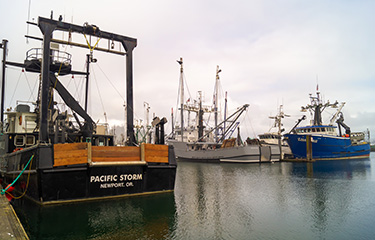U.S. West Coast trade groups and legislators are urging the U.S. Department of Agriculture to up its purchases of local seafood for its school lunch and Ukraine aid food programs.
Over the past year, West Coast seafood suppliers have faced declining domestic demand due to restaurants still struggling from the Covid-19 pandemic and falling seafood exports, the West Coast Seafood Processors said in a letter asking the U.S. Department of Agriculture to up its purchases of Pacific Northwest seafood. Notably, the war in Ukraine has damaged one of its producers’ key markets.
“Ukraine is a significant export market for West Coast harvesters and processors and has historically been the largest market for Pacific hake (whiting),” West Coast Seafood Processors Association Executive Director Lori Steele and executives with the Oregon Trawl Commission, the Fisherman’s Marketing Association, and the Midwater Trawlers Cooperative wrote in the letter.
The U.S. exported nearly USD 95 million (EUR 89 million) worth of seafood products to Ukraine in 2021, according to NOAA.
“The outbreak of war in Ukraine has very significantly impacted these markets,” Steele said.
Even though many more restaurants are operating now than were during the shutdown phase of the pandemic, many have reduced their hours, and consumer traffic is down, the organizations wrote.
“As with most industries, restaurants, notwithstanding fewer COVID-related impediments, continue to face headwinds from supply chain issues, labor shortages, and inflation," they wrote. "Indeed, while grocery store sales of seafood have increased, those gains do not nearly offset the losses of demand from restaurant sales.”
The organizations are urging the USDA to purchase more Pacific pink shrimp, Pacific rockfish fillets, and Pacific hake, also known as whiting.
U.S. Senator Jeffrey Merkley (D-Oregon) and U.S. Sen. Ron Wyden (D-Oregon), along with other legislators, have voiced their support for the USDA to increase purchase of Pacific Northwest and West Coast seafood as part of the agency’s Section 32 program.
“As with rural economies everywhere, but perhaps most acutely in small coastal communities, Covid-19 had a devastating impact and a primary driver of that impact was the effect on the fishing and processing industry,” the legislators wrote.
Ex-vessel revenue for the U.S. West Coast fishing fleet fell 27 percent from 2019 to 2020, and seafood dealers and processors sustained a USD 598 million (EUR 560 million) sales decline – a 13.47 percent drop, they said.
“The West Coast saw a larger decline in revenue from commercial fishing landings than all regions as a whole, with a dip of 24 percent in 2020 as compared to a five-year baseline (2015-2019). NOAA found that a significant part of the lost value was due to restaurant closures and reduced export,” Steele said.
On average, commercial fishermen on the West Coast deliver more than USD 500 million (EUR 468 million) in ex-vessel value per annum, accounting for 14 percent of all U.S. seafood production by value, the legislators wrote. In addition, a quarter of all American seafood processing and wholesale jobs are located in the U.S. states of Washington, Oregon, and California, “representing the largest employment opportunity among all seafood-producing regions in the U.S.,” the legislators said.
In order to make use of surplus seafood, the West Coast Seafood Processors and other groups are urging the USDA to lengthen delivery windows to nine to 12 months on solicitations in 2023.
“A longer delivery window would greatly enhance West Coast producers' ability to fill bids for the full amount of the USDA award, without any vendor constraints,” the trade groups wrote. “While all of our products are available year-round, product packaging specifications and other requirements for the Section 32 program necessitate advanced planning for the processing lines in our facilities.”
Compressed delivery windows, the trade groups wrote, create additional obstacles and costs that can't be avoided and cost more money.
"In 2022, a longer delivery window would have allowed our vendors to more easily fulfill deliveries up to the USD 52 million [EUR 49 million] originally committed by USDA for these products,” they said.
Separately, West Coast producers may be able to take advantage of a new ask from the USDA for bids on wild salmon, ocean perch, and other groundfish for the National School Lunch Program and other Federal Food and Nutrition Assistance Programs.
Bids are due on 74,800 cases of canned pink salmon and groundfish by 10 March, the USDA said in its bid solicitation request. The agency’s plan is to purchase 117,000 cases of ocean perch fillets, 19,800 cases of haddock, and 82,100 cases of Atlantic pollock.
Separately, the Alaska Seafood Marketing Institute said in early February that USD 300,000 (EUR 281,000) worth of canned pink salmon had been shipped to Ukraine as part of a food-aid package.
Following an established procurement process, the contract was awarded to OBI Seafoods in Seattle, Washington, U.S.A. OBI and ASMI worked with Maersk Shipping to deliver the salmon to World Central Kitchen in Ukraine.
Photo courtesy of Oleksiy Oleksyuk/Shutterstock







